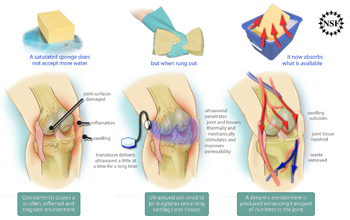All Images
News Release 10-043
(Ultra)Sounding Out a New Way to Treat Chronic Pain
New device may allow affordable, at-home ultrasound treatment of chronic pain from conditions such as arthritis
This material is available primarily for archival purposes. Telephone numbers or other contact information may be out of date; please see current contact information at media contacts.

An osteoarthritic knee has damaged joint surfaces, inflamation and swelling. This creates a stagnant environment. Just like a saturated sponge will not accept more water, the osteoarthritic joint is slow to soak up nutrients. However, ultrasound delivered at a low volume for a long time through a newly designed compact transducer agitates remaining cartilage and tissues. The ultrasound penetrates the joint and tissues. It stimulates the joint thermally and mechanically and improves permeability, creating a dynamic environment conducive to healing. Similar to a sponge that has been wrung out, the treated knee is now able to absorb nutrients. The waste is removed and swelling subsides.
Credit: Zina Deretsky, National Science Foundation
Download the high-resolution JPG version of the image. (465 KB)
Use your mouse to right-click (Mac users may need to Ctrl-click) the link above and choose the option that will save the file or target to your computer.
In recent years, doctors have used ultrasound to effectively treat joint pain from arthritis and other ailments without the use of drugs. The drawback to these treatments, however, is that they can only be administered in a doctor's office or clinic, since the ultrasound devices currently used are bulky and expensive. Enter George K. Lewis, a biomedical engineering graduate student at Cornell University whose research is supported by the National Science Foundation. Lewis has developed a portable ultrasound device about the size of an iPod that can provide pain relief for several hours without being tethered to a doctor's office.
Credit: Cornell University, National Science Foundation


